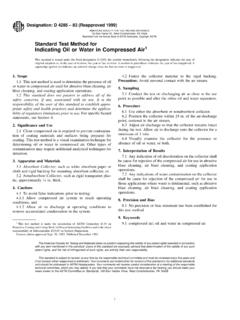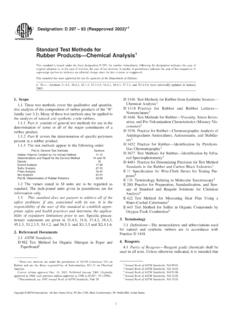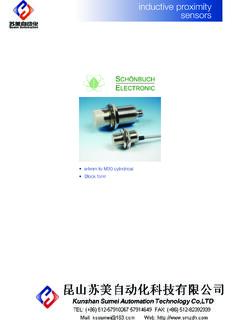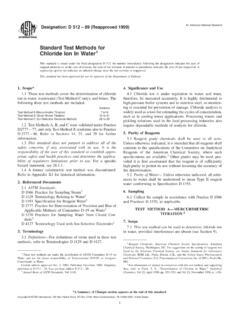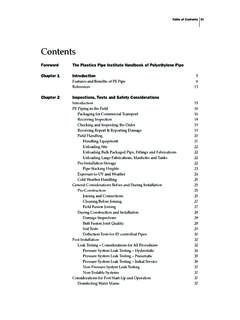Transcription of Standard Specification for Reinforced Epoxy Resin Gas ...
1 Designation: D 2517 00e1An American National StandardStandard Specification forReinforced Epoxy Resin Gas pressure Pipe and Fittings1 This Standard is issued under the fixed designation D 2517; the number immediately following the designation indicates the year oforiginal adoption or, in the case of revision, the year of last revision. A number in parentheses indicates the year of last reapproval. Asuperscript epsilon (e) indicates an editorial change since the last revision or Standard has been approved for use by agencies of the Department of Keywords section was editorially updated in July This specification covers requirements and methods oftest for materials, dimensions and tolerances, hydrostatic-burststrength, chemical resistance, and longitudinal tensile proper-ties, for Reinforced Epoxy Resin pipe and fittings for use in gasmains and services for direct burial and insertion pipe and fittings covered by this specification are intendedfor use in the distribution of natural gas, petroleum fuels(propane air and propane butane vapor mixtures), manufac-tured and mixed gases where resistance to gas permeation,toughness, resistance to corrosion, aging, and deteriorationfrom water, gas, and gas additives are required.
2 Methods ofmarking are also given. Design considerations are discussed inAppendix The values in SI units are to be regarded as the The following safety hazards caveat pertains only to thetest method portion, Section 8, of this specification:Thisstandard does not purport to address all of the safety concerns,if any, associated with its use. It is the responsibility of the userof this Standard to establish appropriate safety and healthpractices and determine the applicability of regulatory limita-tions prior to There is no similar or equivalent ISO A recommended inplant quality control program isgiven in Appendix Referenced standards :D 396 Specification for Fuel Oils2D 543 Test Method for Resistance of Plastics to ChemicalReagents3D 618 Practice for Conditioning Plastics and ElectricalInsulating Materials for Testing3D 883 Terminology Relating to Plastics4D 1598 Test Method for Time-to-Failure of Plastic PipeUnder Constant Internal Pressure4D 1599 Test Method for Short-Time Hydraulic Failure Pres-sure of Plastic Pipe, Tubing, and Fittings4D 1898 Practice for Sampling of Plastics5D 2105 Test Method for Longitudinal Tensile Properties of Fiberglass (Glass-Fiber- Reinforced Thermosetting- Resin )
3 Pipe and Tube4D 2143 Test Method for Cyclic pressure Strength of Rein-forced, Thermosetting Plastic Pipe4D 2290 Test Method for Apparent Tensile Strength of Ringor Tubular Plastics and Reinforced Plastics by Split DiskMethod4D 2412 Test Method for Determination of External LoadingCharacteristics of Plastic Pipe by Parallel-Pipe Loading4D 2924 Test Method for External pressure Resistance of Fiberglass (Glass-Fiber- Reinforced ThermosettingResin) Pipe4D 2992 Practice for Obtaining Hydrostatic or pressure De-sign Basis for Fiberglass (Glass-Fiber-ReinforcedThermosetting-Res in) Pipe and Fittings4D 2996 Specification for Filament Wound Fiberglass (Glass-Fiber- Reinforced Thermosetting- Resin ) Pipe4D 3567 Practice for Determining Dimensions of Fiber-glass (Glass-Fiber- Reinforced Thermosetting Resin )Pipe and Fittings4D 3839 Practice for Underground Installation of Fiber-glass (Glass-Fiber- Reinforced Thermosetting Resin )Pipe4D 3892 Practice for Packaging/Packing of PlasticsD 5685 Specification for Fiberglass (Glass-Fiber- Reinforced Thermosetting- Resin ) pressure Pipe Fittings1 This specification is under the jurisdiction of ASTM Committee D20 onPlastics and is the direct responsibility of Subcommittee on ReinforcedPlastic Piping edition approved July 10, 2000.
4 Published September 2000. Originallypublished as D2517 66. Last previous edition D2517 Book of ASTM standards , Vol Book of ASTM standards , Vol Subcommittee D hascompleted work to develop methods which are adapted for Book of ASTM standards , Vol Book of ASTM standards , Vol ASTM International, 100 Barr Harbor Drive, PO Box C700, West Conshohocken, PA 19428-2959, United General Definitions are in accordance with Termi-nology D 883 or F 412. Abbreviations are in accordance withTerminology D 1600, unless otherwise indicated. The abbre-viation for fiberglass pipe is RTRP and the abbreviation forfiberglass fittings is The gas industry technology used in this specificationis in accordance with definitions given in The Department ofTransportation of Natural and Other Gas by Pipeline MinimumSafety Reinforced Thermosetting Resin Pipe Ma-terials Designation Code The pipe material designation codeshall consist of the abbreviation RTRP followed by type andgrade in arabic numerals, class by a capital letter and the longterm steady pressure strength by a second capital letter.
5 Thefittings material designation shall consist of the abbreviationRTRF followed by type (method of manufacture), grade(general type of Resin ), class (configuration of joining system),and pressure The pipe covered in this specification is made bythe filament winding process and is described in SpecificationD 2996. Requirements of this pipe are based on short-term testsdefined in this This specification covers Reinforced epoxyresin fittings described in specification D 5685 and made of thetype of materials covered in Section 5, which are capable ofbeing joined to the pipe and will provide a suitable gasdistribution The resins and reinforcements used to make pipe shallbe as specified in This specification covers glass fiber Reinforced epoxyresin pipe and fittings as defined in Specification D 2996 RTRP 11 AU and RTRP 11 CU and fittings as defined inspecification D 5685-RTRF 11A1D, RTRF 21A1D, RTRF11F2D and RTRF The particular Reinforced thermosetting Resin included ini-tially in this specification for gas pressure piping was selected on the basisof engineering test studies made by Battelle Memorial Institute, experi-mental use in field installations.
6 And technical data supplied by themanufacturers of the plastics materials used to make the pipe and is the intent of ASTM Committee D-20 on Plastics to consider forinclusion other resins and reinforcements in this specification whenevidence is presented to show that they are suitable for gas requirements are an ASTM pipe specification and long-termstrength determined in accordance with Test Method D 2992, ProcedureB, in addition to the requirements of this The pipe and fittings shall be free ofvisible cracks, holes, foreign inclusions, blisters, and otherinjurious defects. The pipe and fittings shall be as uniform ascommercially practicable in color, opacity, density, and otherphysical Dimensions and The outside diameter of the pipe shall bein accordance with Table 1 when measured in accordance Thickness The wall thickness of the pipe shallmeet the requirements given in Table 1 when measured inaccordance with The pipe shall be in lengths as specified onthe purchase order when measured in accordance with Either threaded adaptors or bonded joints are of up to 5 % of the shipment are acceptable to meet the lengthrequirements.
7 No section less than m (5 ft) long can be used to makea joint and only one jointer can be used in a Dimensions and Tolerances The fittings di-mensions shall enable the pipe and fittings to be joined andshall be measured in accordance with Subcommittee D is working towards development ofdimensional requirements for fittings; however, it will be some timebefore the requirements are available. Therefore, the method of measuringis provided only to have a Standard method of measuring fittingsdimensions for inspection Rupture Strength(Burst pressure ) Theminimum hoop stress at burst for pipe covered by thisspecification shall be as listed in Table 2 when tested inaccordance with The minimum burst requirements forfittings covered by this specification shall be MPa (700psi) internal pressure or MPa (4000 psi) hoop tensilestress, whichever is greater, when tested in accordance with temperatures of 23 C ( F) and C (150 F), andcalculated using the equation listed in Test Method D 1599 forhoop stress.
8 The calculations shall use the fittings wall thick-ness and diameter at a point where the wall thickness is at aminimum and which is also in the section of the fittings whichis not Reinforced by the Strength The minimum stiffness factor at 5 %deflection of the pipe shall be as shown in Table 2 when testedin accordance with Test Method D Resistance The pipe shall not change morethan612 % in apparent tensile strength when measured inaccordance with 1 Pipe Dimensions, mm (in.)NominalOutside DiameterToleranceMinimum Wall ( )+ , (+ , ) ( ) ( )+ , (+ , ) ( ) ( )+ , (+ , ) ( ) ( )+ , (+ , ) ( ) ( )+ , (+ , ) ( ) ( )+ , (+ , ) ( ) ( )+ , (+ , ) ( )D 2517 00e12 NOTE5 A suitable chemical resistance test for fittings is not availableat the present time and will be added when (Tensile Strength) The minimum longi-tudinal tensile strength for pipe covered by this specificationshall be as listed in Table 2 when tested in accordance with TestMethod D Collapse The minimum factor for pipecovered by this specification shall be as listed in Table 2 whentested in accordance with Test Method D Adhesive Adhesives used to join Reinforced Epoxy Resin pipe shallbe suitable for use with the pipe and fittings and meet therequirements listed in and It is recommended that the working (pot)
9 Life of the adhesivebe agreed upon between the purchaser and the Test All adhesives covered by this specifica-tion shall have a minimum ultimate shear strength of MPa(1500 psi) when tested in accordance with Each adhesive kit shall contain the neces-sary components and instruction sheets, which shall includecure times and pot Test Take a sample of the pipe and fittingssufficient to determine conformance with this 15 m (50 ft) of pipe or tubing are required to make thetests prescribed. The number of fittings required varies, de-pending upon the size and type of fitting. It is suggested that asampling plan be agreed upon by the purchaser and themanufacturer (see Practice D 1898). Unless otherwise specified, conditionthe specimens prior to test at 2362 C ( F) and 5065 % relative humidity for not less than 48 h, in accordancewith Procedure A of Practice D 618 for those tests whereconditioning is required and in all cases of Conditions Conduct the tests in the StandardLaboratory Atmosphere of 2362 C ( F), unlessotherwise and Thickness and Diameter Determine in accor-dance with Practice D Thickness When the test specimens contain aliner, determine the average liner thickness in accordance withPractice D Hydrostatic Failure Strength (MinimumHoop Stress) Determine in accordance with Test MethodD 1599.
10 Fittings shall be tested with pipe nipples bonded in Tensile Properties The apparent tensilestrength shall be determined in accordance with Procedure B ofTest Method D Resistance Determine the resistance to thefollowing chemicals in accordance with Procedure II of TestMethod D 543, except use ring specimens cut from pipe forthis purpose:ChemicalConcentration, %Fuel Oil No. 1 (Specification D 396)100t-butyl mercaptan5 in fuel oilAntifreeze agents (at least one shall be used):Methanol100 Isopropanol100 Ethylene glycol100 Cut specimens from the pipe in accordance with ; test fivespecimens with each reagent. Coat specimen edges withadhesive prior to immersion. Completely immerse the speci-mens in the chemicals for 72 h. Upon removal from thechemicals, wipe the specimens with a clean dry cloth, condi-tion in the testing room for a period not to exceed 2 h, and thentest in tension in accordance with Test The ultimate shear strength for adhe-sives used to bond pipe and fittings together shall be deter-mined in accordance with the following procedure; it isapplicable to all adhesives covered by this Laboratory shear specimens are made bybonding together two 3 by 13 by 75-mm (1 8by1 2by 3-in.)

